| Common name | Binomial name | Population | Status | Trend | Notes | Image |
|---|
| Amur Leopard | Panthera pardus orientalis | 20-30 [1] | CR [1] |  [1] [1] | Numbers have fluctuated in recent censuses. [1] |  |
| Iriomote cat | Prionailurus bengalensis iriomotensis | 100–109 [2] | CR [3] |  [3] [3] | A subspecies of the leopard cat living exclusively on the Japanese island of Iriomote. Population size is declining, and consists of a single subpopulation. [2] | 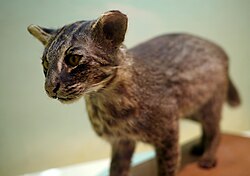 |
| Malabar large-spotted civet | Viverra civettina | 250 [4] | CR [4] |  [4] [4] | Maximum estimate. Previously considered possibly extinct. [4] |  |
| Darwin's fox | Pseudalopex fulvipes | 250 [5] | EN [5] |  [5] [5] | Maximum estimate for mature individuals. [5] |  |
| Black-footed ferret | Mustela nigripes | 500 [6] | EN [6] |  [6] [6] | Almost became extinct in the 1980s. [6] | |
| Red wolf | Canis rufus | 300 [7] | CR [7] |  [7] [7] | Maximum estimate. No more than 50 mature individuals. Previously extinct in the wild. [7] |  |
| Saimaa ringed seal | Pusa hispida saimensis | 380 | EN |  | The most endangered pinniped. | 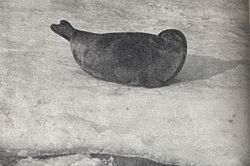 |
| Cozumel raccoon | Procyon pygmaeus | 323–955 [8] | CR [8] |  [8] [8] | Mature individuals number less than 250. Populations can be severely affected by hurricanes. [8] |  |
| Ethiopian wolf | Canis simensis | 500 [9] | EN [9] |  [9] [9] | One of the world's rarest canids, and Africa's most endangered carnivore. | 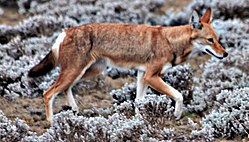 |
| Siberian tiger | Panthera tigris tigris | 560 [10] | EN [10] |  [10] [10] | Siberian tigers have made a comeback from the brink of extinction due to the strict laws of the Russian government. Russian Authorities believe that the number of living Siberian tigers will reach 700 after four years. [10] | 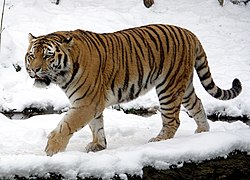 |
| Asiatic lion | Panthera leo leo | 674 [11] | EN [11] |  [11] [11] | The population is rapidly growing from 284 in 1990 to 674 in 2020 thanks to the conservation efforts of the government, people and many communities. It is only found in the Gir forest and some other parts of the state of Gujrat, India. [11] |  |
| Mediterranean monk seal | Monachus monachus | 700 [12] | VU [12] |  [12] [12] | The second most endangered pinniped. [12] |  |
| Marine otter | Lontra felina | 1,000 [13] | EN [13] |  [13] [13] | Maximum estimate from 1991; numbers have probably fallen. [13] | 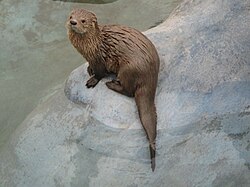 |
| Giant otter | Pteronura brasiliensis | 1,000–5,000 [14] | EN [14] |  [14] [14] | |  |
| Iberian lynx | Lynx pardinus | 1,100 [15] | VU [16] |  [16] [16] | According to European Union LIFE Nature conservation projects estimates population size tripled from 52 mature individuals in 2002 to 156 in 2012. [16] |  |
| Hawaiian monk seal | Neomonachus schauinslandi | 1,400 [17] | EN [17] |  [17] [17] | Numbered 1448 in 1983. [17] | 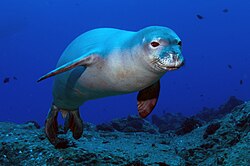 |
| Giant panda | Ailuropoda melanoleuca | 1,800 [18] | VU [18] |  [18] [18] | Maximum estimate for mature individuals. [18] | 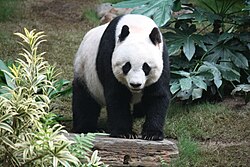 |
| Bay cat | Pardofelis badia | 2,200 [19] | EN [19] |  [19] [19] | Maximum estimate. [19] | 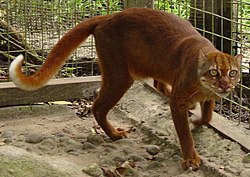 |
| Dhole | Cuon alpinus | 2,500 [20] | EN [20] |  [20] [20] | Maximum estimate for mature individuals. [20] |  |
| Fossa | Cryptoprocta ferox | 2,500 [21] | VU [21] |  [21] [21] | Maximum estimate. [21] | 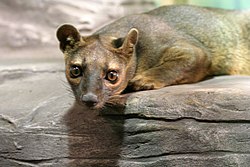 |
| Andean mountain cat | Leopardus jacobita | 2,500 [22] | EN [22] |  [22] [22] | Maximum estimate. [22] |  |
| Grandidier's mongoose | Galidictis grandidieri | 2,650–3,540 [23] | EN [23] |  [23] [23] | | 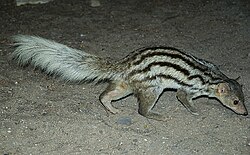 |
| Snow leopard | Panthera uncia | <8,000 [24] | VU [24] |  [24] [24] | |  |
| Bengal Tiger | Panthera tigris tigris | 2,967 [25] | EN [25] |  [25] [25] | The population is rapidly growing and it has been doubled from 1,411 to 2,967 in 12 years. According to the census report, the population has been risen 30% from 2,226 in 2014 to 2,967 in 2020 thanks to the strict laws of Indian government. [25] |  |
| Tiger | Panthera tigris | 3,900-5,600 [26] | EN [26] |  [26] [26] | 75% of the tigers in the world belongs to India. 13 countries including India, Bangladesh, Myanmmar, Bhutan, China, Russia have taken a misson to double the worldwide tiger population by the year 2022. [26] |  |
| Island fox | Urocyon littoralis | 4,001 [27] | NT |  [27] [27] | | 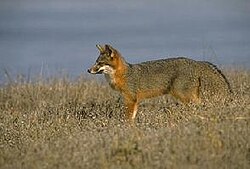 |
| Sunda clouded leopard | Neofelis diardi | 4,500 [28] | VU [28] |  [28] [28] | Maximum estimate. [6] |  |
| African wild dog | Lycaon pictus | 6,600 [29] | EN [29] |  [29] [29] | |  |
| Cheetah | Acinonyx jubatus | 7,100 [30] | VU [30] |  [30] [30] | Estimate is for mature individuals only. Number may reach as high as 10,000. [30] | 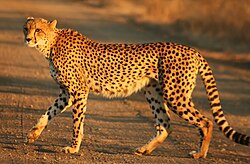 |
| Brown hyena | Parahyaena brunnea | 8,000 [31] | NT [31] |  [31] [31] | |  |
| Eurasian lynx | Lynx lynx | 8,000 (Europe only) [32] | LC [32] |  [32] [32] | |  |
| Marbled cat | Pardofelis marmorata | 10,000 [33] | NT [33] |  [33] [33] | Maximum estimate. [33] |  |
| Rusty-spotted cat | Prionailurus rubiginosus | 10,000 [34] | NT [34] |  [34] [34] | |  |
| Clouded leopard | Neofelis nebulosa | 10,000 [35] | VU [35] |  [35] [35] | Maximum estimate for mature individuals. [35] |  |
| Red panda | Ailurus fulgens | 10,000 [36] | EN [36] |  [36] [36] | |  |
| African golden cat | Caracal aurata | 10,000 [37] | VU |  [37] [37] | Minimum estimate for mature individuals. [37] | 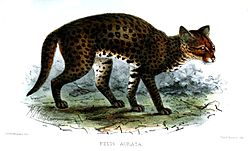 |
| Chinese mountain cat | F. bieti | 10,000 [38] | VU [38] |  [38] [38] | Maximum estimate for mature individuals. [38] | 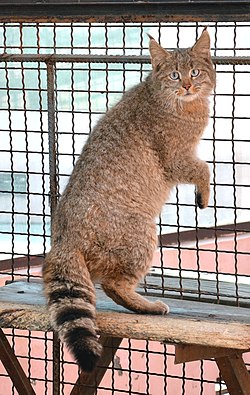 |
| Galápagos fur seal | Arctophoca galapagoensis | 10,000–15,000 [39] | EN [39] |  [39] [39] | Down from 30,000–40,000 in 1978. [39] |  |
| New Zealand sea lion | Phocarctos hookeri | 11,855 [40] | EN [40] |  [40] [40] | |  |
| Juan Fernández fur seal | Arctophoca philippii | 12,000 [41] | LC [41] |  [41] [41] | Estimate is from the early 1990s; numbers appear to be increasing. [41] |  |
| Australian sea lion | Neophoca cinerea | 13,790 [42] | EN [42] |  [42] [42] | |  |
| Striped hyena | Hyaena hyaena | 14,000 [43] | NT [43] |  [43] [43] | |  | | |
| Sechuran fox | Lycalopex sechurae | 15,000 [44] | NT [44] | Unknown [44] | Maximum estimate for mature individuals. [44] |  |
| Guadalupe fur seal | Arctophoca townsendi | 15,000–17,000 [45] | LC [45] |  [45] [45] | Numbered 200 – 500 in the 1950s. [45] | 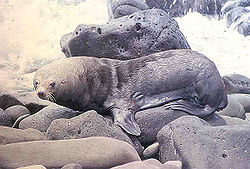 |
| Kodkod | Leopardus guigna | 18,000 [46] | VU [46] |  [46] [46] | Maximum estimate. [46] | 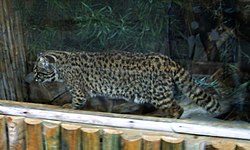 |
| Leopard seal | Hydrurga leptonyx | 18,000-35,000 [47] | LC [47] | Unknown [47] | |  |
| Sloth bear | Melursus ursinus | 20,000 [48] | VU [48] |  [48] [48] | Maximum estimate. [48] | 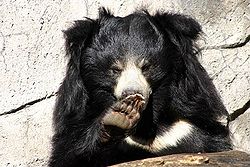 |
| Lion | Panthera leo | 20,000 [49] | VU [49] |  [49] [49] | Comprises two subspecies in Africa and Asia. The Asiatic lion numbers an estimated 650. [50] |  |
| Galápagos sea lion | Zalophus wollebaeki | 20,000–40,000 [51] | EN [51] |  [51] [51] | |  |
| Polar bear | Ursus maritimus | 22,000–31,000 [52] | VU [52] |  [52] [52] | |  |
| Maned wolf | Chrysocyon brachyurus | 23,600 [53] | NT [53] | Unknown [53] | |  |
| Spotted hyena | Crocuta crocuta | 27,000–47,000 [54] | LC [54] |  [54] [54] | Tentative estimate. [54] |  |
| Asian black bear | Ursus thibetanus | 50,000 [55] | VU [56] |  [56] [56] | Maximum estimate. [56] |  |
| Cougar | Puma concolor | 50,000 [57] | LC [57] |  [57] [57] | |  |
| Jaguar | Panthera onca | 64,000 [58] | NT [58] |  [58] [58] | |  |
| Leopard | Panthera pardus | 75,000 [59] | VU [59] |  [59] [59] | | 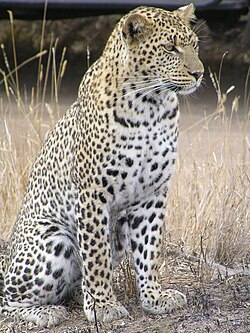 |
| Baikal seal | Pusa sibirica | 80,000–100,000 [60] | LC [60] |  [60] [60] | |  |
| Sea otter | Enhydra lutris | 106,822 [61] | EN [61] |  [61] [61] | | 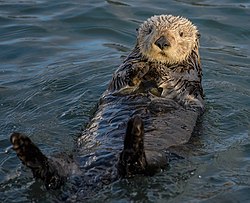 |
| Bush dog | Speothos venaticus | 110,000 [62] | NT [62] |  [62] [62] | Considered an overestimate. [62] | 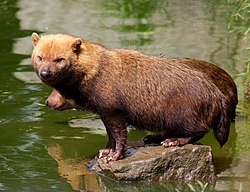 |
| Caspian seal | Pusa caspica | 111,000 [63] | EN [63] |  [63] [63] | Once numbered over 1,000,000. [63] | 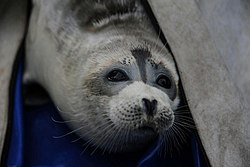 |
| Ross seal | Ommatophoca rossii | 130,000 [64] | LC [64] | Unknown [64] | |  |
| Steller sea lion | Eumetopias jubatus | 143,000 [65] | NT [65] |  [65] [65] | Divided into two subspecies: Western Steller (78,000) and Loughlin's Steller (65,000). [65] |  |
| Northern elephant seal | Mirounga angustirostris | 171,000 [66] | LC [66] |  [66] [66] | Numbered 113,000 in 1991. [66] | 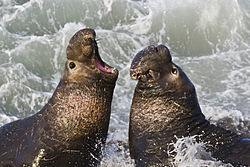 |
| California sea lion | Zalophus californianus | 180,000 [67] | LC [67] |  [67] [67] | |  |
| Brown bear | Ursus arctos | 200,000 [68] | LC [68] |  [68] [68] | Minimum estimate. Russia has the largest number of brown bears, believed to exceed 100,000, while estimates in the U.S. are around 33,000 (most in Alaska), Canada 25,000, and Europe (excluding Russia) 14,000. [68] |  |
| New Zealand fur seal | Arctophoca forsteri | 200,000 [69] | LC [69] |  [69] [69] | |  |
| Subantarctic fur seal | Arctophoca tropicalis | 200,000 [70] | LC [70] |  [70] [70] | [70] |  |
| South American sea lion | Otaria flavescens | 250,000 [71] | LC [71] |  [71] [71] | Minimum estimate. [71] | 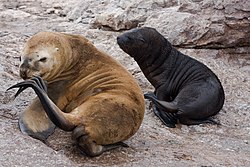 |
| South American fur seal | Arctophoca australis | 250,000–300,000 [72] | LC [72] |  [72] [72] | |  |
| Grey wolf | Canis lupus | 300,000 [73] | LC | Unknown | |  |
| Weddell seal | Leptonychotes weddellii | 300,000 [74] | LC [74] | Unknown [74] | [74] |  |
| Harbor seal | Phoca vitulina | 315,000 [75] | LC [75] | Unknown [75] | Founded in the coastal regions of North America, Europe and Asia. [75] | 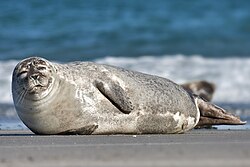 |
| Grey seal | Halichoerus grypus | 316,000 [76] | LC [76] |  [76] [76] | |  |
| Southern elephant seal | Mirounga leonina | 325,000 [77] | LC [77] | Unknown [77] | Latest global estimates are from the mid-1990s. [77] |  |
| Hooded seal | Cystophora cristata | 340,000 [78] | VU [78] |  [78] [78] | One population in the Northwest Atlantic and another in the Northeast. The latter population has declined 85-90% in the past 60 years for unknown reasons. [78] |  |
| Northern fur seal | Callorhinus ursinus | 650,000 [79] | VU [79] |  [79] [79] | | 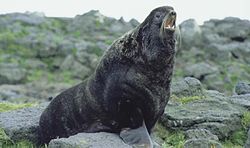 |
| American black bear | Ursus americanus | 950,000 [80] | LC [80] |  [80] [80] | Numbers are believed to be twice that of all other bears combined. [80] |  |
| Brown fur seal | Arctocephalus pusillus | 1,060,000 [81] | LC [81] |  [81] [81] | Divided into two subspecies: Cape and Australian. [81] |  |
| Crabeater seal | Lobodon carcinophaga | 4,000,000 [82] | LC [82] | Unknown [82] | [82] |  |
| Harp seal | Pagophilus groenlandicus | 4,500,000 [83] | LC [83] |  [83] [83] | [83] |  |
| Red fox | Vulpes vulpes | Unknown [84] | LC |  | Estimates are uncertain because a coordinated worldwide census has never been conducted. [84] |  |
| Cat (domestic) | Felis catus | 600,000,000 [85] | Domesticated |  [85] [85] | 2007 estimate |  |
| Dog (domestic) | Canis familiaris | 900,000,000 [86] | Domesticated |  [86] [86] | |  |











































 |
|







































